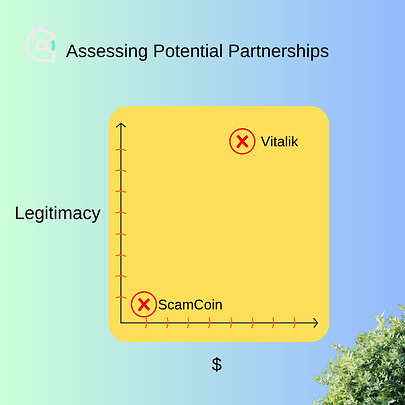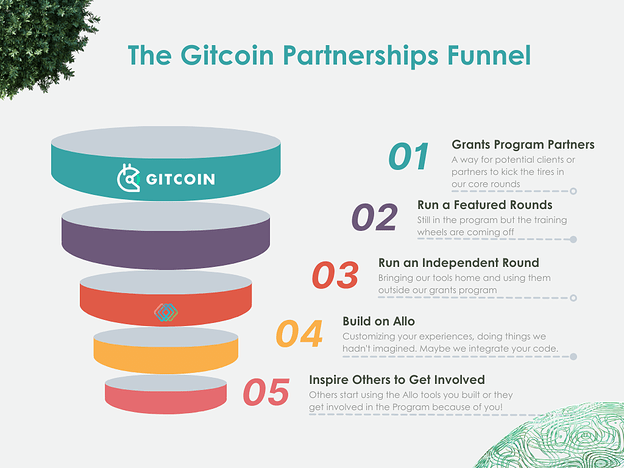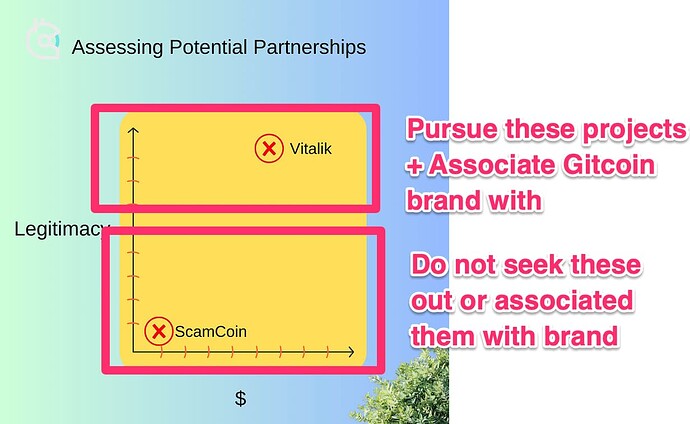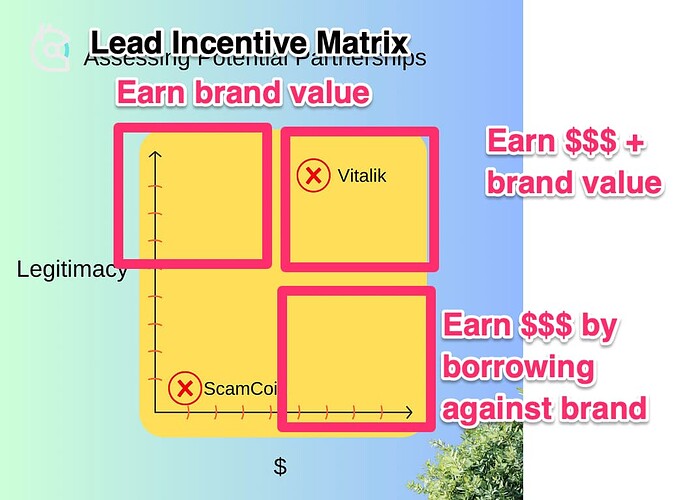Hey friends, thanks for getting involved in this important conversation.
The recent discussion of a controversial matching fund partnership has led to a healthy discussion of how partnership decisions are currently made at Gitcoin. The assessment of a potential partnership historically has been done using a 2 axis decision making matrix. On the X axis is the amount of potential funding and on the Y axis is the legitimacy or credibility of the potential partner.
The problem with this system is of course the qualitative nature of assessing legitimacy or credibility. That being said, generally this process has served us well as an informal way to discuss the potential benefits and trade-offs of a partnership. There has also always been discussion about potential partnerships amongst contributors and team members. The sensitive nature of negotiating contract details has made it challenging to meaningfully engage the community more fully in this process and doing so after a contract is finalized seems counterproductive in terms of the time and energy spent on business development and relationship building. So what do we do?
Much of my background is in non-profits and civil society organizations, many of these kind of organizations have partnership policies that exclude whole industries or sectors from consideration for partnerships. I would like to propose that for the Gitcoin Grants Program we take a similar approach. For example weapons manufacturers, hate groups (like the KKK for example), the tobacco industry and fossil fuel companies could be excluded from consideration for partnerships as part of the quarterly grants program if that is what the community believes would be appropriate.
This would not mean that these companies could not use Gitcoin Grants Stack tools or build on top of Allo Protocol, the open source code that makes everything possible. What it would mean is that these potential partnerships would not be tied to our quarterly grants program, nor would they be highlighted by our main Gitcoin Twitter account (aka “Momma Gitcoin”) or other primary communications channels like our email newsletter.
I see the Grants Program like the top of a funnel of engagement. For many it is the first exposure they have to Gitcoin and the first way they get involved and experience the magic of quadratic funding as a funding mechanism. This could be as a donor, a grantee or a matching fund partner.
Now that we also have the ability for anyone to run their own grants program using our tools we are working on how best to support those that wish to move along this “funnel” from experiences in our program into other ways to engage with our tools directly. This includes supporting those who skip over that first step and go directly to using Grant Stack or even those who might start building something new on Allo. Implementing “guard rails” in the form of some overarching directives for the partnerships team could help us direct the flow of these conversations to the appropriate place and ensure that everyone’s time is well spent.
Even with such rules in place of course there will always be edge cases. For example some ETH Killer blockchains might seem like a great partnership to some and controversial to others. Or a company might not be controversial but their CEO might be problematic in the eyes of community members because of stances they have taken on issues. My superstar colleague @MathildaDV has proposed a detailed structure for how we could deal with these edge cases that takes into consideration the various teams and work streams involved in this process. Kudos for the thoughtful work on this discussion document Mathilda!
So what do you think? In terms of a process for implementing this idea this is what I’m suggesting:
1: It would be great if we could start with further conversation here in the gov forum over the next couple weeks about this idea and what guardrails community members would feel were appropriate.
2: The PGF team could then bring forth a formal proposal based on this discussion for a vote for our token holding stewards on snapshot with an outcome finalized in early october 2023.
3: If adopted this new framework could be in place before our next quarterly grants round and the would determine
Cool?
To be clear this proposal could also change how we roll out existing partnerships as well as new partnerships.
Big thanks to @azeem @connor @Sov and everyone else who helped shape this proposal.
All feedback would be very much appreciated. Please help spread the word to anyone with an interest in this conversation.




